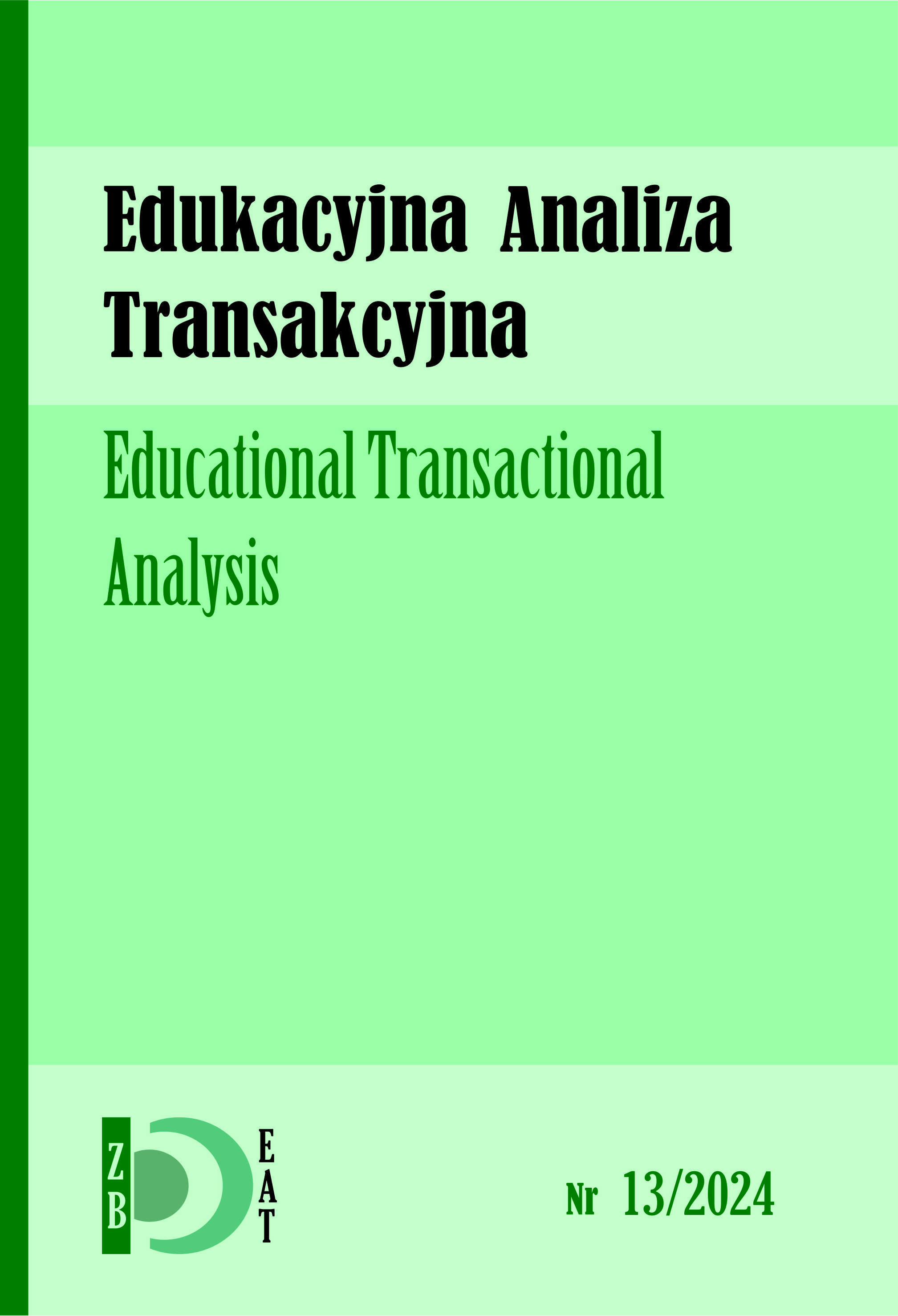It’s not that I'm "abnormal". Social and emotional experiences of women with autism spectrum (AS) related to the diagnosis in adulthood
DOI:
https://doi.org/10.16926/eat.2024.13.20Keywords:
autism spectrum, female autism phenotype, diagnosis, biographical narrative interviewAbstract
The paper is part of a research project related to the preparation of the master’s thesis of Magdalena Wala, a fifth-year student of Special Education, prepared under the scientific supervision of Dr. Sabina Pawlik. The research concerns the social and emotional experiences of women diagnosed as late as in adulthood. Compared to men, women are more likely to remain undiagnosed in childhood, thus belonging to the so-called “lost generation”, i.e. people who are deprived of the opportunity to be diagnosed in childhood. One of the reasons is that women with autism spectrum (AS) have a different behavioral pattern (female autism phenotype) than men and the established diagnostic practices are focused on the basic characteristics of AS that were historically established based on the symptoms in men. The aim of the research was to learn about the social and emotional experiences of women with AS who were diagnosed in adulthood. It was associated with women’s experiences before the diagnosis (related to the diagnostic process itself) and experiences after the diagnosis. The research found that women with AS in adulthood saw the value of the diagnosis in the form of increased self-knowledge, liberation from stigmatizing labels, finding their “tribe” and the possibility of receiving forms of support adequate to their condition.
Downloads
References
Bargiela, S., Steward, R., & Mandy, W. (2016). The experiences of late-diagnosed women with autism spectrum conditions: An investigation of the female autism phenotype. Journal of Autism and Developmental Disorders, 46(10), 3281–3294. https://doi.org/10.1007/s10803-016-2872-8
Buchholz, A. (2021). Kobiety ze stanami ze spektrum autyzmu – zarys charakterystyki funkcjonowania. Człowiek - Niepełnosprawność - Społeczeństwo, 52(2), 61–74. https://doi.org/10.5604/01.3001.0015.0625
Buchholz, A. (2023). Maskowanie w autyzmie – analiza zjawiska. Szkoła Specjalna, 84(3), 183–193. https://doi.org/10.5604/01.3001.0053.8978
Campbell, M. (2018). Finding your tribe. In B. W. Cook & M. Garnett (Eds.), Spectrum women: Walking to the beat of autism (pp. 21–32). Jessica Kingsley Publishers.
Corden, K., Brewer, R., & Cage, E. (2021). Personal identity after an autism diagnosis: Relationships with self-esteem, mental wellbeing, and diagnostic timing. Frontiers in Psychology, 12, 699335. https://doi.org/10.3389/fpsyg.2021.699335
Duvekot, J., van der Ende, J., Verhulst, F. C., Slappendel, G., van Daalen, E., Maras, A., & Greaves-Lord, K. (2017). Factors influencing the probability of a diagnosis of autism spectrum disorder in girls versus boys. Autism, 21(6), 646–658. https://doi.org/10.1177/1362361316672178
Flick, U. (2007). Designing qualitative research. SAGE Publications. https://doi.org/10.4135/9781849208826
Happé, F. G., Mansour, H., Barrett, P., Brown, T., Abbott, P., & Charlton, R. A. (2016). Demographic and cognitive profile of individuals seeking a diagnosis of autism spectrum disorder in adulthood. Journal of Autism and Developmental Disorders, 46(11), 3469–3480. https://doi.org/10.1007/s10803-016-2886-2
Hendrickx, S. (2015). Women and girls with autism spectrum disorder: Understanding life experiences from early childhood to old age. Jessica Kingsley Publishers.
Hull, L., Mandy, W., Lai, M.-C., Baron-Cohen, S., Allison, C., Smith, P., & Petrides, K. (2019). Development and validation of the Camouflaging Autistic Traits Questionnaire (CAT-Q). Journal of Autism and Developmental Disorders, 49, 819–833. https://doi.org/10.1007/s10803-018-3792-6
Hull, L., Petrides, K. V., & Mandy, W. (2020). The female autism phenotype and camouflaging: A narrative review. Review Journal of Autism and Developmental Disorders, 7(4), 306–317. https://doi.org/10.1007/s40489-020-00197-9
Hull, L., Petrides, K. & Mandy, W. (2021). Cognitive Predictors of Self-Reported Camouflaging in Autistic. Autism Research, 14(3), 523-532. https://doi.org/10.1002/aur.2407
Hull, L., Petrides, K., Allison, C., Smith, P., Baron-Cohen, S., Lai, M.-C., & Mandy, W. (2017). "Putting on my best normal": Social camouflaging in adults with autism spectrum conditions. Journal of Autism and Developmental Disorders, 47, 2519–2534. https://doi.org/10.1007/s10803-017-3166-5
Kaźmierska, K. (2016). Wywiad narracyjny – technika i pojęcia analityczne. In R. Dopierała & K. Waniek (Eds.), Biografia i wojna. Metoda biograficzna w badaniu procesów społecznych. Wybór tekstów (p. 61–71). Wydawnictwo Uniwersytetu Łódzkiego.
Konecki, K. (2005). Analiza danych jakościowych. Procesy i procedury. Przegląd Socjologiczny, 54(1-2), 67–282. https://czasopisma.ltn.lodz.pl/Przeglad-Socjologiczny/article/download/936/850
Lai, M.-C. & Baron-Cohen, S. (2015). Identifying the lost generation of adults with autism spectrum conditions. The Lancet Psychiatry, 2(11), 1013-1027. https://doi.org/10.1016/S2215-0366(15)00277-1
Noy, C. (2008). Sampling knowledge: The hermeneutics of snowball sampling in qualitative research. International Journal of Social Research Methodology, 11(4), 327-344. https://www.ssoar.info/ssoar/handle/document/5386
Pawlik, S. (2019). Diagnoza spektrum autyzmu u osób dorosłych jako biograficzny przełom. Kultura i edukacja, 23(1), 216–229. https://doi.org/10.15804/kie.2019.01.13
Perry, E., Mandy, W., Hull, L. & Cage, E. (2022). Understanding Camouflaging as a Response to Autism Related Stigma: A Social Identity Theory Approach. Journal of Autism and Developmental Disorders 52, 800-810. https://doi.org/10.1007/s10803-021-04987-w
Rutherford, M., McKenzie, K., Johnson, T., Catchpole, C., O'Hare, A., McClure, I., Forsyth, K., McCartney, D., & Murray, A. (2016). Gender ratio in a clinical population sample, age of diagnosis and duration of assessment in children and adults with autism spectrum disorder. Autism, 20(5), 628-634. https://doi.org/10.1177/1362361315617879
Rynkiewicz, A., Janas-Kozik, M., & Słopień, A. (2018). Dziewczęta i kobiety z autyzmem. Psychiatria Polska, 54(4), 737-752. https://doi.org/10.12740/PP/OnlineFirst/95098
Sławińska, A. (2014). Zespół Aspergera u osób dorosłych – zbieżność z innymi zaburzeniami, zaburzenia współwystępujące i problemy towarzyszące. Psychiatria i psychologia kliniczna, 14(4),304-307. https://doi.org/10.15557/PiPK.2014.0041
Straus, J. N. (2013). Autism as culture. In L. J. Davis (Ed.), The Disability Studies Reader (p. 460–484). Routledge.
Downloads
Published
How to Cite
Issue
Section
License
Copyright (c) 2024 Sabina Pawlik, Magdalena Wala

This work is licensed under a Creative Commons Attribution 4.0 International License.
I am aware that the Educational Transactional Analysis journal is published under a Creative Commons license - Attribution (https://creativecommons.org/licenses/by/4.0/legalcode).
By submitting the article, I agree to make it available under this license

